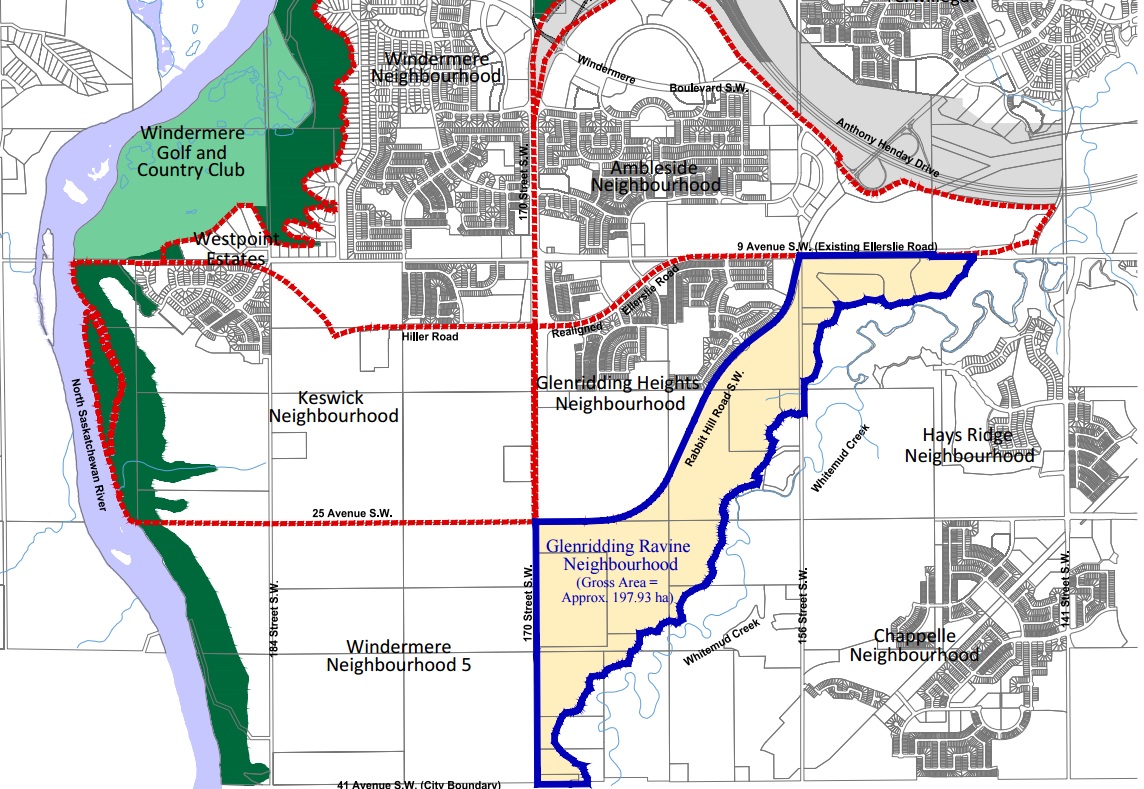Southwest Edmonton could soon be getting a new neighbourhood if the neighbourhood structure plan is adopted by city council.

The plan for Glenridding Ravine goes before a public hearing at city hall on Monday afternoon.
The neighbourhood would have a northern edge of Ellerslie Road, an eastern edge of Whitemud Creek Ravine, a southern boundary of 41 Avenue SW and a western boundary of 170 Street and Rabbit Hill Road.
The area currently contains undeveloped agricultural lands, farmsteads, a golf course and natural areas.
READ MORE: City of Edmonton offers glimpse into long-term plan for growth
The neighbourhood, which would accommodate roughly 8,000 residents, covers 197 hectares and is adjacent to Windermere, Ambleside, Keswick and Glenridding Heights.
The neighbourhood would include 60 per cent low density residential housing, such as single or semi detachments, and 40 per cent medium density residential housing, such as row housing and low-rise or medium density housing.
Area councillor Bryan Anderson said the density of Glenridding Ravine would be two to four times the density of mature neighbourhoods in Edmonton. He said it makes sense to build out instead of up centrally in the city.
“It is the city’s responsibility to provide a wide variety of residential accommodation from low, medium and high-priced condos, townhouses, apartment rentals and single family housing. If we do not provide a choice in residential accommodation, people will go to any one of the four counties or jurisdictions like Sherwood Park or St. Albert,” he said.
He said there is an appeal to living farther away from the core of the city.
“I’m not sure that I know a whole bunch of 20-year-olds that aspire to grow up and raise a family in a high-rise apartment,” he said. “I think there are many, many people who have always planned on eventually, if they get married and if they raise a family, to have a house of their own.”
A report prepared for council earlier this year said southwest Edmonton is expected to have “some of the largest growth in Edmonton projected to the year 2025.”
“The planning for Glenridding Ravine at 8,000 does indicate that the city’s plan to create more dense neighbourhoods is actually happening,” Anderson said.
Earlier this year, a report found that three communities on Edmonton’s outskirts will cost more than the taxes they are expected to bring in. The city expects the projected cumulative shortfall to be $1.4 billion. That is not expected to happen with this new neighbourhood.
“Our city grew consistently from its beginnings to today. There has been forever, and I think it will probably continue, whether or not building new neighbourhoods will create property tax revenue that will pay for the services they require,” Anderson said.
A report on the Neighbourhood Structure Plan by Stantec found Glenridding Ravine, which is a narrow linear piece of land with unique geography, will “create design challenges and opportunities in order to ensure a balance of amenities.” Because the eastern edge runs along Whitemud Creek, there is an initiative to protect the ravine from urban development while also promoting public access to it.
The neighbourhood would also include a transit centre along with commercial space and a variety of park options.
Development is expected to start next year and is estimated to be complete within 10 years.




Comments